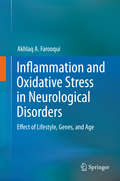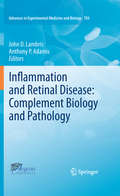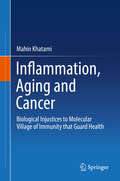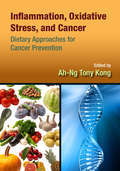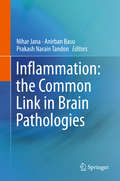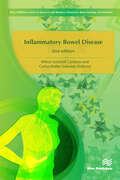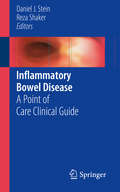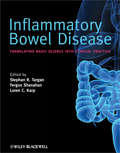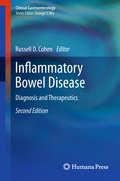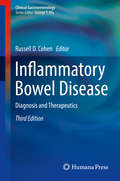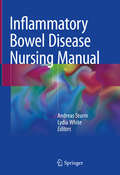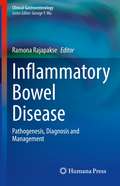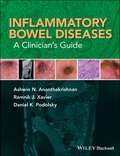- Table View
- List View
Inflammation and Lung Cancer
by Steven M. DubinettIn recent years there have been various discoveries connecting inflammation and lung cancer and clearly there is growing interest in this area of cancer research. The link between unresolved inflammation and cancer has been well established with estimates that 15% of cancer deaths are inflammationrelated. Evidence for this link includes the following: a) some inflammatory diseases are associated with increased risk of cancer development; b) inflammatory mediators are present surrounding and within most tumors; c) overexpression of inflammatory cytokines increases cancer development and progression in murine studies; d) inhibition of inflammatory mediators decreases cancer development and progression; and e) the use of nonsteroidal antiinflammatory drugs (NSAIDs) has been found to decrease cancer incidence and delay progression. The volume will present aspects of the inflammatory tumor microenvironment (TME), its many roles in tumor progression and metastasis, including creation of a hypoxic environment, increased angiogenesis and invasion, changes in expression of microRNAs (miRNAs) and an increase in a stem cell phenotype. The book will also cover the mechanisms of inflammatory mediators. Chronic overexpression of inflammatory mediators in the TME, as seen in smokers and patients with nonsmall cell lung cancer (NSCLC), can also lead to increased tumor initiation, progression, invasion and metastasis. The volume will provide a comprehensive perspective of the latest findings and summaries of progress made regarding inflammation and its connection to lung cancer.
Inflammation and Metastasis
by Yoshiro MaruThis book provides the latestinformation on cancer metastasis from the standpoint of inflammation,especially innate immune reactions caused by endogenous mediators but notexogenous pathogens, with ideas on how to understand the complicated mechanismsof metastasis as well as to interpret therapeutic targets. The book includesthe topic of the emerging roles of endogenous TLR4 ligands whose functions areshared intriguingly by metastasis and auto-inflammatory diseases such asrheumatoid arthritis. For example, most cancer therapies established so far areeffective initially. However, they eventually face the great obstacles of drugresistance, immune evasion, and metastatic progression. One of the endogenousTLR4 ligands is thought to contribute to all three processes. The mostimportant features of the book are to explain a concept of homeostaticinflammation, disturbance of which in the lungs gives rise to the establishmentof a pre-metastatic pulmonary microenvironment based on primary tumor-mediatedhijacking of the innate immune defense system against respiratory infection. Inaddition, structure-based thinking is another important feature of this book. It is proposed that inflammation forms a functional triangle with angiogenesisand coagulation, in the center of which cancer is located. Given the proposal of precision medicineby President Obama in the United States in 2015 and the recent success ofimmune-modulator-based therapy, this book will appeal to researchers in avariety of fields with the title of the book connecting the worst disease(metastasis) and the most fundamental event (inflammation) that is common tomany diseases.
Inflammation and Metastasis
by Yoshiro MaruThis book, now in a thoroughly revised and updated second edition, provides the latest information on cancer metastasis from the perspective of inflammation and presents new ideas on the complicated mechanisms of metastasis and potential therapeutic targets. Key features include discussion of mechanisms recently identified to be involved in the resolution phase of inflammation, presentation of the latest evidence regarding the roles of endogenous TLR4 ligands in metastasis, and thorough explanation of the concept of homeostatic inflammation and current understanding of the significance of its dysregulation for metastasis. Structure-based thinking is another important element of the book, and it is proposed that inflammation forms a functional triangle with angiogenesis and coagulation, at the center of which cancer is located. Examples of the many additional specific topics covered in this edition include the functional involvement of new types of RNA in cancer, the insights offered by recent advances in bioinformatics, and the potential of a casein kinase 1α inhibitor in the treatment of acute myeloid leukemia. The book will be a valuable update and resource for both experienced and younger researchers. Homeostasis, originated from an idea of internal milieu by Claude Bernard, is eventually maintained by endogenous elements. The essential features of inflammation are leukocyte mobilization and increased vascular permeability, which could take place in many homeostatic or physiological conditions at low levels. Homeostatic inflammation is a concept to explain pathological settings such as metastasis in which irrespective of its level those inflammatory features are misused with endogenous molecules (see Chap. 14,15). As inflammation comprises many biological fields, targeting a single molecule for a disease could potentially make a therapeutic contribution to other diseases. For example, one focus is applied here to the roles of calprotectin in lung metastasis, which is implicated in psychiatric disorders and COVID-19 as shown by recent evidence.
Inflammation and Oxidative Stress in Neurological Disorders
by Akhlaq A. FarooquiUnless new discoveries are made in the prevention or treatment of stroke, Alzheimer's Disease and depression, the number of patients with these diseases is sure to increase dramatically by the year 2050. Thus, developing strategies to retard or delay the onset of stroke, AD and depression these neurological disorders is of critical important. The present monograph will provide current and comprehensive information on the relationship between neuroinflammation and oxidative stress in age-related neurological disorders at the molecular level. The information described in this monograph on lifestyle (diet and exercise), genes and age is intended to facilitate and promote new discoveries for the treatment of age-related neurological disorders.
Inflammation and Retinal Disease: Complement Biology and Pathology
by John D. Lambris Anthony P. AdamisComprehensive look at the pathology and biology of retinal inflammation. Written by current, respected opthamologists and eye researchers. Reports on age-related degeneration, gene-associations, and other physiological pathways to retinal inflammation. Numerous studies have pointed to the key role of complement in the pathogenesis of retinal disease, particularly age-related macular degeneration (AMD). Reports about new gene associations and links to other physiological pathways are emerging almost on a weekly base. Several promising clinical candidates covering a wide area of potential treatment applications are in the pipelines of both industrial and academic groups. This indicates an increasing interest in complement as a therapeutic target. In view of these exciting discoveries, scientists from around the world convened at the 1st Aegean Conferences Conference on Inflammation and Retinal Disease: Complement Biology and Pathology (June 10-17, 2007) in Crete, Greece, to discuss recent advances in this rapidly-evolving field. This volume represents a collection of topics on the functions of complement in eye diseases, pathophysiology, protein structures, and complement therapeutics discussed during the conference.
Inflammation in Parkinson's Disease
by Madhavi ThomasParkinson's Disease (PD) is a progressive neurodegenerative disease with a prevalence of 0. 1% of the global population, and 5-10% patients are under 40 years of age. Several text books have been published on various aspects of PD to date, including research and clinical aspects. However these do not emphasize the inflammatory pathways and pathways of neurodegeneration in PD. Inflammation in Parkinson's Disease brings advances in research together with current literature and evidence This concise volume covers the fundamentals of neuroimmunology and inflammatory models, the interactions between pathways of neurodegeneration and follows the concept of research work undertaken from basic science to clinical trials. Researchers, clinicians, and students interested in Parkinson's Disease are provided with a comprehensive view of translational research methods and an insight needed for developing future therapies aimed at disease modulation.
Inflammation, Aging and Cancer
by Mahin KhatamiThis book was prepared as extension of author's accidental discoveries on experimental models of acute and chronic ocular inflammatory diseases that were established at the University of Pennsylvania in 1980's. Analyses of original data suggest a series of first evidence for direct link between inflammation and developmental phases of immune dysfunction in multistep tumorigenesis and angiogenesis. The only evidence presented on initial events for interactions and synergies between activated host and recruiting cells toward tumorigenesis. Effective immunity was defined as balance between two highly regulated and biologically opposing arms, Yin and Yang of acute inflammation, an amazingly precise signal communications between immune and non-immune systems requiring differential bioenergetics. Unresolved inflammation is a common denominator mapping aging process and induction of 'mild', 'moderate' or 'severe' immune disorders including cancers. Our knowledge of the fascinating biology of immunity in health or chronic diseases is fragmentary, chaotic and confusing, particularly for cancer science. Lack of progress in curing majority of chronic diseases or cancer is primarily due to the fact that scientists work on isolated molecules/cells or topics that are funded and promoted by decision makers in medical/cancer establishment. Despite existence of over 25 million articles on cancer-related topics, cancer biology and cure remain mysteries to be solved. After a century of cancer research, the failure rates of therapies for solid tumors are 90% (+/-5). Current reductionist views on cancer science are irresponsible, shut-gun approaches and create chaos. Outcomes are loss of millions of precious lives and economic drain to society. Very little is known about initial events that disturb effective immunity whose function is to monitor and arrest growth of cancerous cells or defend against other external or internal hazardous agents that threaten body's survival. The author demonstrates the serious need for systematic understanding of how immune disruptors and aging process would alter effective immunity. Outcomes of proposed orderly studies are expected to provide logical foundations for cost-effective strategies to promote immunity toward a healthier society. The policy makers and medical/cancer establishment are urged to return to the common sense that our Forefathers used to serve the public.
Inflammation, Aging, and Oxidative Stress
by Stephen C. Bondy Arezoo CampbellThe book describes the major degenerative processes and pathologies exacerbated by senescence and how they can be alleviated through retardation of cellular aging. Topics discussed include neurodegenerative disease, protein oxidation, cerebrovascular disease, particle-induced inflammation and cardiovascular disease, Alzheimer's disease, ovarian aging, dietary and endogenous anti-oxidants in management of Parkinson's disease, and effects of exercise on oxidation and inflammation. The nineteen expertly authored chapters are organized into three sections in order to present a complete picture to the reader: Age Related Cellular Events, Role of Inflammatory and Oxidative Processes in Age-Related Diseases, and Retardation of Cellular Aging. Inflammation, Oxidative Stress and Age-Related Disease draws from a variety of international perspectives and provides a comprehensive overview of the relationship between disease, cell aging, and oxidative stress, as well as potential for preventing or slowing these processes. This installment of Springer's Oxidative Stress in Applied Basic Research and Clinical Practice is ideal for researchers, clinicians, and advanced graduate students in the fields of cardiology, neuroscience, biogerontolgy, and cell biology.
Inflammation, Infection, and Microbiome in Cancers: Evidence, Mechanisms, and Implications (Physiology in Health and Disease)
by Jun SunThis book offers a summary and discussion of the advances of inflammation and infection in various cancers. The authors cover the classically known virus infections in cancer, novel roles of other pathogens (e.g. bacteria and fungi), as well as biomarkers for diagnosis and therapy. Further, the chapters highlight the progress of immune therapy, stem cells and the role of the microbiome in the pathophysiology of cancers.Readers will gain insights into complex microbial communities, that inhabit most external human surfaces and play a key role in health and disease. Perturbations of host-microbe interactions often lead to altered host responses that can promote cancer development. Thus, this book highlights emerging roles of the microbiome in pathogenesis of cancers and outcome of therapy. The focus is on mechanistic concepts that underlie the complex relationships between host and microbes. Approaches that can inhibit infection, suppress chronic inflammation and reverse the dysbiosis are discussed, as a means for restoring the balance between host and microbes.This comprehensive work will be beneficial to researchers and students interested in infectious diseases, microbiome, and cancer as well as clinicians and general physiologists.
Inflammation, Lifestyle and Chronic Diseases: The Silent Link (Oxidative Stress and Disease)
by Bharat B. Aggarwal Sunil Krishnan Sushovan GuhaOxidative stress and inflammation are among the most important factors of disease. Chronic infections, obesity, alcohol and tobacco usage, radiation, environmental pollutants, and high-calorie diets have been recognized as major risk factors for a variety of chronic diseases from cancer to metabolic diseases. All these risk factors are linked to ch
Inflammation, Oxidative Stress, and Cancer: Dietary Approaches for Cancer Prevention
by Ah-Ng Tony KongIncreasing scientific evidence suggests that the majority of diseases including cancer are driven by oxidative stress and inflammation, attributed to environmental factors. These factors either drive genetic mutations or epigenetically modify expression of key regulatory genes. These changes can occur as early as gestational fetal development, and
Inflammation: From Molecular and Cellular Mechanisms to the Clinic
by Mervyn Singer Jean-Marc CavaillonThe leading reference on this topic of increasing medical relevance is unique in offering unparalleled coverage. The editors are among the most respected researchers in inflammation worldwide and here have put together a prestigious team of contributors. Starting with the molecular basis of inflammation, from cytokines via the innate immune system to the different kinds of inflammatory cells, they continue with the function of inflammation in infectious disease before devoting a large section to the relationship between inflammation and chronic diseases. The book concludes with wound and tissue healing and options for therapeutic interventions. A must have for clinicians and biomedical researchers alike.
Inflammation: the Common Link in Brain Pathologies
by Nihar Jana Anirban Basu Prakash Narain TandonThis unifying theme of this book-with sections on mechanisms of defense and neuropathogenesis, neurological diseases, infections of the nervous system, neuropharmacology, and novel therapies-is interactions of the immune and nervous systems. It also discusses the role of inflammation as a key mediator of different brain disorders. There have been significant scientific advances in the multidisciplinary field of neuroimmunology / neuroinflammation in the past decade, and this book, edited under the guidance of Professor P. N. Tandon, fosters communication between those who share an interest in this exciting area, including neuroscientists, immunologists, cell biologists, clinicians and neuropharmacologists.
Inflammatory Arthritis in Clinical Practice
by David L. Scott Ian C. Scott James B. GallowayUnderstanding the key components of the diagnosis, assessment and management of inflammatory arthritis patients is essential to improving patient care. This book aims to cover these areas. It places inflammatory arthritis into a historical context; deals with the epidemiology, pathology, clinical assessment and investigation of inflammatory arthritis patients and provides a comprehensive overview of currently available treatment options. It provides insight into stratified medicine, an area of emerging importance in the management of heterogeneous diseases like RA. Finally, it provides an overview of what treatments strategies are in development.
Inflammatory Bowel Disease
by Wilton Schmidt Cardozo Carlos Walter SobradoInflammatory Bowel Disease, 2nd edition presents updated information about inflammatory bowel disease in health-care workers. The theoretical content is based on controlled and randomized clinical studies in the meta-analyzes, conducted appropriately and especially in global consensus and led by international experts. As such, the reader has access the important topics required to understand the ulcerative colitis and Crohn's disease.The editors and chapter authors, all established names within gastroenterology and coloproctology, and having extensive experience in assisting patients with inflammatory bowel disease, provide a concise book with quick and objective reference texts that complement the knowledge of students, doctors, nurses, nutritionists and psychologists of daily clinical practice.
Inflammatory Bowel Disease
by Reza Shaker Daniel J. SteinThis title provides a point-of-care reference for busy clinicians who need the best evidence based answers to patient questions at their fingertips. Additionally, it guides clinicians through the complicated therapeutic management of IBD including drug initiation, medications side effects and complications, therapeutic level monitoring and accurate disease monitoring. Lastly, it addresses special situations such as alternative therapies, pregnancy, fertility, and lactation. Inflammatory Bowel Disease: A Point-of-Care Reference Guide will be a valuable reference for Gastroenterologists, Gastroenterology Fellows and Mid-Level Providers.
Inflammatory Bowel Disease
by Serge Dibart DmdPractical Advanced Periodontal Surgery offers a step-by-step guide to cutting-edge surgical techniques as well as interdisciplinary treatment approaches in periodontology. It details procedures in a practical, succinct, thorough and accessible way, profiling more complex and advanced procedures, through a user-friendly and highly visual format. By presenting an innovative approach to each treatment modality, Practical Advanced Periodontal Surgery provides predictable solutions to complex daily dental challenges.
Inflammatory Bowel Disease
by Fergus Shanahan Stephan R. Targan Loren C. KarpThis is the state-of-the-art book on inflammatory bowel disease you have been waiting forWritten and edited by international experts in gastroenterology this up-to-date volume provides a complete review of the basic science behind inflammatory bowel disease (IBD), as well as evidence-based clinical guidance on diagnosis, treatment and long-term management of IBD.In 50 chapters the authors cover the latest and most promising treatment modalities and the science behind them. There are chapters which cover the advances in the medical and surgical treatment of conditions such as Crohn's disease and ulcerative colitis, as well as chapters focusing on nutrition, imaging and complementary medicine.This is an invaluable information resource for all those in the medical team treating patients with IBD. Whether you are a gastroenterologist, gastrointestinal surgeon or GI nurse specialist this book deserves a place in your library.
Inflammatory Bowel Disease
by Russell D. CohenAs in the first edition of Inflammatory Bowel Diseases this new edition continues to provide readers with a concise, yet in-depth review of many of the important areas in the history, epidemiology, pathogenesis, diagnosis, and treatment of the inflammatory bowel diseases (ulcerative colitis and Crohn's disease), as well as associated issues: extraintestinal manifestations, ostomy care, women's issues, economics, etc. This Second Edition provides the reders with up-to-date, state-of-the art approaches to these disease states, with expansion into the newer topics that have emerged in the past few years which include the expansion of biological agents for treatment, new studies in the epidemiology of IBD, the changing economics of IBD, breakthroughs in new endoscopic evaluations, major advances in novel radiographic techniques, the detection of colorectal cancer in patients with IBD and new findings in the genetics of IBD. New Trend / Developments (* These all emerged since our last edition) The most critical trend that has arisen over the past few years has been the introduction and expansion of biological agents in the treatment of inflammatory diseases worldwide. While only one agent, infliximab (Remicade), existed at the time of publication of my first edition, there have been multiple other agents either approved or pending approval for the treatments of these diseases, or in the upper-stages of development. The impact is not only upon the patients, but also on the health-care providers, policy makers, researchers, biotech and pharmacompanies, and the business community. Major changes worldwide in the epidemiology of IBD has spurred new studies in the demographics of who is getting these diseases and why. Previously characterized as diseases primarily affected Caucasians in industrialized countries, there has been an explosion of growth amongst the African American and Hispanic populations in the United States, and well as in pockets of these and other ethnic groups worldwide. The economics of IBD has been changing greatly, given the issues raised above, as well as major changes in the United States Medicare program, and other insurance changes. The growing proportion of the GNP that healthcare costs are consuming in the US and worldwide has shifted attention to decreasing utilization of health care services, and other cost-savings measures. Again, up to this point this has been an exclusive part of our IBD book. New findings in the genetics of IBD have been recently published. Our first edition had the finding of the first Crohn's disease gene inserted just before going to press; so much has been published about the phenotypes and other genotypes that have emerged. Breakthroughs in new endoscopic evaluations of the bowel (ie. Capsule endoscopy, double-balloon enteroscopy, endoscopic ultrasound) and their use in the inflammatory bowel diseases will be a key highlight of this new book. Major advances in novel radiographic techniques employed in patients with inflammatory bowel disease (ie. CT enterography, MR enterography, advanced ultrasounds, etc.) will also an important component of our work. There have been numerous areas related to the development and detection of colorectal cancer in patients with IBD that have emerged in the past few years. Techniques of better detection (ie. Narrow band imaging; special mucosal staining; endoscopic histological evaluations) as well as research in the putative role of mesalamine and other agents for colorectal cancer prevention are all hot topics that will attract much interest from a variety of interest groups I described above. Identification of additional disease states that probably belong in the IBD family, such as microscopic colitis (including lymphocytic colitis), and collagenous colitis add to the diseases that will be discussed in this new edition.
Inflammatory Bowel Disease
by Russell D. CohenAs in the first edition of Inflammatory Bowel Diseases this new edition continues to provide readers with a concise, yet in-depth review of many of the important areas in the history, epidemiology, pathogenesis, diagnosis, and treatment of the inflammatory bowel diseases (ulcerative colitis and Crohn's disease), as well as associated issues: extraintestinal manifestations, ostomy care, women's issues, economics, etc. This Second Edition provides the reders with up-to-date, state-of-the art approaches to these disease states, with expansion into the newer topics that have emerged in the past few years which include the expansion of biological agents for treatment, new studies in the epidemiology of IBD, the changing economics of IBD, breakthroughs in new endoscopic evaluations, major advances in novel radiographic techniques, the detection of colorectal cancer in patients with IBD and new findings in the genetics of IBD. New Trend / Developments (* These all emerged since our last edition) The most critical trend that has arisen over the past few years has been the introduction and expansion of biological agents in the treatment of inflammatory diseases worldwide. While only one agent, infliximab (Remicade), existed at the time of publication of my first edition, there have been multiple other agents either approved or pending approval for the treatments of these diseases, or in the upper-stages of development. The impact is not only upon the patients, but also on the health-care providers, policy makers, researchers, biotech and pharmacompanies, and the business community. Major changes worldwide in the epidemiology of IBD has spurred new studies in the demographics of who is getting these diseases and why. Previously characterized as diseases primarily affected Caucasians in industrialized countries, there has been an explosion of growth amongst the African American and Hispanic populations in the United States, and well as in pockets of these and other ethnic groups worldwide. The economics of IBD has been changing greatly, given the issues raised above, as well as major changes in the United States Medicare program, and other insurance changes. The growing proportion of the GNP that healthcare costs are consuming in the US and worldwide has shifted attention to decreasing utilization of health care services, and other cost-savings measures. Again, up to this point this has been an exclusive part of our IBD book. New findings in the genetics of IBD have been recently published. Our first edition had the finding of the first Crohn's disease gene inserted just before going to press; so much has been published about the phenotypes and other genotypes that have emerged. Breakthroughs in new endoscopic evaluations of the bowel (ie. Capsule endoscopy, double-balloon enteroscopy, endoscopic ultrasound) and their use in the inflammatory bowel diseases will be a key highlight of this new book. Major advances in novel radiographic techniques employed in patients with inflammatory bowel disease (ie. CT enterography, MR enterography, advanced ultrasounds, etc. ) will also an important component of our work. There have been numerous areas related to the development and detection of colorectal cancer in patients with IBD that have emerged in the past few years. Techniques of better detection (ie. Narrow band imaging; special mucosal staining; endoscopic histological evaluations) as well as research in the putative role of mesalamine and other agents for colorectal cancer prevention are all hot topics that will attract much interest from a variety of interest groups I described above. Identification of additional disease states that probably belong in the IBD family, such as microscopic colitis (including lymphocytic colitis), and collagenous colitis add to the diseases that will be discussed in this new edition.
Inflammatory Bowel Disease Nursing Manual
by Andreas Sturm Lydia WhiteThis comprehensive manual discusses the many aspects of inflammatory bowel disease (IBD), providing relevant information along with practical guidance. The reader is also directed to additional resources for extra and current information. This book comes at a time when the number of people suffering from the two major forms of IBD, ulcerative colitis (UC) and Crohn’s disease (CD), is rising around the globe. Despite their huge impact on daily life and health economics, these diseases are not fully understood, and diagnosis and treatment remains a significant challenge. IBD nurses are increasingly recognised as key clinicians within the multidisciplinary team caring for people with IBD. Through experience and specialist knowledge IBD nurses provide timely support, advice, and treatment for people living with this unpredictable condition. IBD nurses are also well placed to liaise with the wider team, developing patient centred services which best fit their local health framework. The combined international expertise and accessible guidance here will equip nurses, or any clinician wanting to increase their competence in IBD management. Thereby this manual aims to contribute to the optimisation of IBD care throughout the world.
Inflammatory Bowel Disease Nursing Manual
by Andreas Sturm Lydia WhiteBuilding on the success of the first edition, this new and expanded edition explores the complexities of inflammatory bowel disease (IBD) with an expanded focus on the viewpoint and experience of those living with IBD and the interface of clinical care and research opportunities. With cases of ulcerative colitis (UC) and Crohn&’s disease (CD) rising worldwide, the need for informed, patient-centered care has never been greater. Despite their profound impact on daily life and healthcare systems, these conditions remain challenging to diagnose and treat. IBD nurses are increasingly recognised as key clinicians within the multidisciplinary team caring for people with IBD. Through experience and specialist knowledge, IBD nurses provide timely support, advice, and treatment for people living with this unpredictable condition. IBD nurses are also well placed to liaise with the wider team; developing patient centred services which best fit their local health framework. This updated manual brings together international expertise and practical insights to support nurses and clinicians in optimizing IBD management. Whether you&’re a seasoned professional or looking to expand your expertise, this resource equips you with the knowledge and confidence to enhance care and improve outcomes for people living with IBD wherever in the world you work.
Inflammatory Bowel Disease: Pathogenesis, Diagnosis and Management (Clinical Gastroenterology)
by Ramona RajapakseThis book uses new thinking on precision medicine and the interplay of genetic factors, the microbiome, and external triggers to build on the core concepts of inflammatory bowel disease. It outlines the latest findings in targeting therapies to the individual patient with Crohn’s and colitis, management of chronic infections in the setting of immunomodulators and biologics, non-surgical therapy of dysplasia in colitis patients, and redefining and structuring the problematic pouch. In addition, this book features useful chapters dedicated to the economic aspects of IBD in an increasingly constrained healthcare system, as well as the patient experience and the role of subspecialist telemedicine care.Written by specialists and thought leaders in the field, Inflammatory Bowel Disease: Pathogenesis, Diagnosis and Management provides a concise but highly relevant account of the latest thinking and concepts in IBD.
Inflammatory Bowel Diseases: A Clinician's Guide
by Daniel K. Podolsky Ashwin N. Ananthakrishnan Ramnik J. XavierInflammatory Bowel Diseases: A Clinician’s Guide provides practical guidance for the diagnosis and management of those suspected or known to have one of the forms of these complex diseases. It is perfect both for gastroenterology trainees learning to care for these patients and the experienced physician as a concise and practical resource for day to day use. Written by the experts, Inflammatory Bowel Diseases: A Clinician’s Guide is an essential tool for all gastroenterologists managing patients with inflammatory bowel disease.
Inflammatory Breast Cancer
by Jaime G. de la Garza-Salazar Claudia Arce-Salinas Abelardo Meneses-GarciaThis book aims to bring together clinical information on the biology, diagnosis, therapy and management of patients with inflammatory breast cancer. Authored by experts from the Instituto Nacional de Cancerologia in Mexico, this book will provide the reader with the state-of-the art treatment of this rare but pernicious disease.



